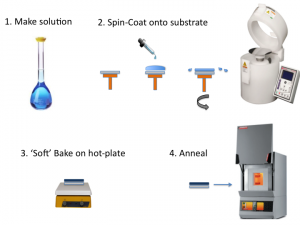Students and post-docs in the Page lab work on all aspects of materials synthesis, ranging from preparation of bulk solids and gels to thin films, and characterization using XRD, XRR, SEM, EPMA, XPS and ToF-SIMS. In addition, there are multiple opportunities to work with collaborators to learn specialized techniques, such as solid-state NMR, pair-distribution function analysis (PDF), electrical device fabrication, and magnetic measurements. Students will enjoy personalized attention in our small, tight-knit group while also benefitting from the collaborative nature of the larger CSMC community.
Most of the current research centers on aqueous routes to metal oxide films, described below.
Aqueous routes to metal oxide thin films.
The general process employed for aqueous solution deposition involves spin-casting homogeneous solutions of metal salts or clusters onto a flat substrate to form a thin film, then annealing the film to remove water and counterions and to promote cross-linking (condensation) to form a continuous metal oxide network, as illustrated in the cartoon below.
There are several facets to our work in this area:
1) Development of this technique to produce high quality metal oxide thin films at relatively low temperatures for a range of applications, ranging from dielectric gate oxide films to ferroelectric films.
2) Developing a detailed understanding of the chemistry involved in film formation and densification.
3) Developing the use of new and known powerful analytical tools for studying the structural evolution of amorphous films to inform studies of the film formation chemistry.
Examples of these types of studies are given in the research links.
